Trip Report - Tokyo, Matsumoto & Takayama
#22
>> dipped the soba noodles into the broth.
You did the correct thing. That cold soba was on a zaru sitting in the boat. The dish is called zaru soba. I love it. It is a fairly common dish (minus the boat) that you can probably find at a Japanese restaurant near you.
Maybe you saw that pouring the sauce on the soba would have made a mess of the zaru and maybe the boat.
You did the correct thing. That cold soba was on a zaru sitting in the boat. The dish is called zaru soba. I love it. It is a fairly common dish (minus the boat) that you can probably find at a Japanese restaurant near you.
Maybe you saw that pouring the sauce on the soba would have made a mess of the zaru and maybe the boat.
#24
Join Date: Feb 2003
Posts: 3,202
Likes: 0
Received 0 Likes
on
0 Posts
Nice trip report. Did you write this as you traveled or take notes or have a great memory? Your eating habits are not that unusual for people from the US. My daughter is very similar to you. Must be because she was born in Connecticut. There is actually a fair amount of chicken and pork eaten in Japan. My daughter likes Karaage which is basically Japanese fried chicken. You might someday want to try Tonkatsu which is fried pork, often served on top of rice. The zaru soba in your photograph comes with two vessels of the same sauce. If you run out of sauce in the main bowl on the right you replenish it with the sauce in the cup on the left. Most people add the sliced green onion and the Daikon oroshi ( the white grated Japanese turnip) to the dipping sauce.
The Uniqlo store near your Tokyo hotel is one of the large branches in Tokyo. My daughters love the store and you can get the popular Uniqlo bag monogramed at that particular location. They also love Don Quixote.
Lastly you are lucky to have traveled when you did as the dollar is/was really strong against the yen. The dollar has not been this strong against the yen for many decades.
The Uniqlo store near your Tokyo hotel is one of the large branches in Tokyo. My daughters love the store and you can get the popular Uniqlo bag monogramed at that particular location. They also love Don Quixote.
Lastly you are lucky to have traveled when you did as the dollar is/was really strong against the yen. The dollar has not been this strong against the yen for many decades.
#25
Original Poster
Join Date: Sep 2005
Posts: 500
Likes: 0
Received 0 Likes
on
0 Posts
mrwunrfl - I'm glad I made the right decision about dipping my soba noodles into the broth! As you thought, for a moment I considered pouring the broth over the noodles in the boat but realized what a mess that would make. Between the chicken and the noodles it was a filling meal....might I say, fulfulling  . I really wanted to have at least one genuine Japanese meal during my trip so my loss of the wasabi farm was soba noodle gain.
. I really wanted to have at least one genuine Japanese meal during my trip so my loss of the wasabi farm was soba noodle gain.
mjs - when I'm on a trip, each night I dictate the day's experiences into an email which I then transcribe and edit once I'm home. They tend to be a bit stream of consciousness so I clean them up for posting - no one wants to hear whining. Last time I was in Japan I ate tonkatsu pretty often and this time I had a lot of fried chicken. I could have spent more time & money in Uniqlo but I had no room in my luggage and really don't need anything; I wish I done the monogrammed bag though...oh well! I lucked out with the yen vs dollar rate so my trip ended up being under budget - which means more money for travels!Day 10 –Takayama (April 6)
overcast with some sun; mid-60s.
Wow, do I love places like this! There’s so much to see and absorb for a history geek; my mind is like a sponge just soaking it all up. On my way to the Takayama Jinya, which was a govt office for the 265 years of the Edo era. Just before you reach the entrance area, is the Jinya-mae Market. Unlike the Miyagawa Market, this market is entirely stands set up in an open area that sell local crafts, snacks and farm products. It felt more local than the other market to me; I bought a mini-apple tart for later and enjoyed looking at all the produce and handmade goods.
Takayama was such an important site that officials were sent from the capital Edo to perform administrative duties like tax collection, finance, court, rulings and police action. This building served as the offices for all those functions as well as residences for the officials sent to do them (and their bodyguards, wives and maids). It seems like a maze of rooms with different administrative purposes, hallways, porches facing onto the interior courtyard, rooms for functionaries to wait their turn in, tea ceremony room, living space (separate areas for the officials and their families versus the maids and bodyguards), separate kitchens. It’s set up with a one-way route through the complex but you can take as much time as you like in each room. It’s a destination for tour groups and individual tourists but most people just walk through like they’re on a race track, whereas I step to the side, study the room, look up and down, look at the exhibits, etc. This is yet another site that I can really picture operating back in the old days and long kimonos sweeping the ground and scribes transcribing everything. Reading Shogun while I’m here has been extremely helpful for me.
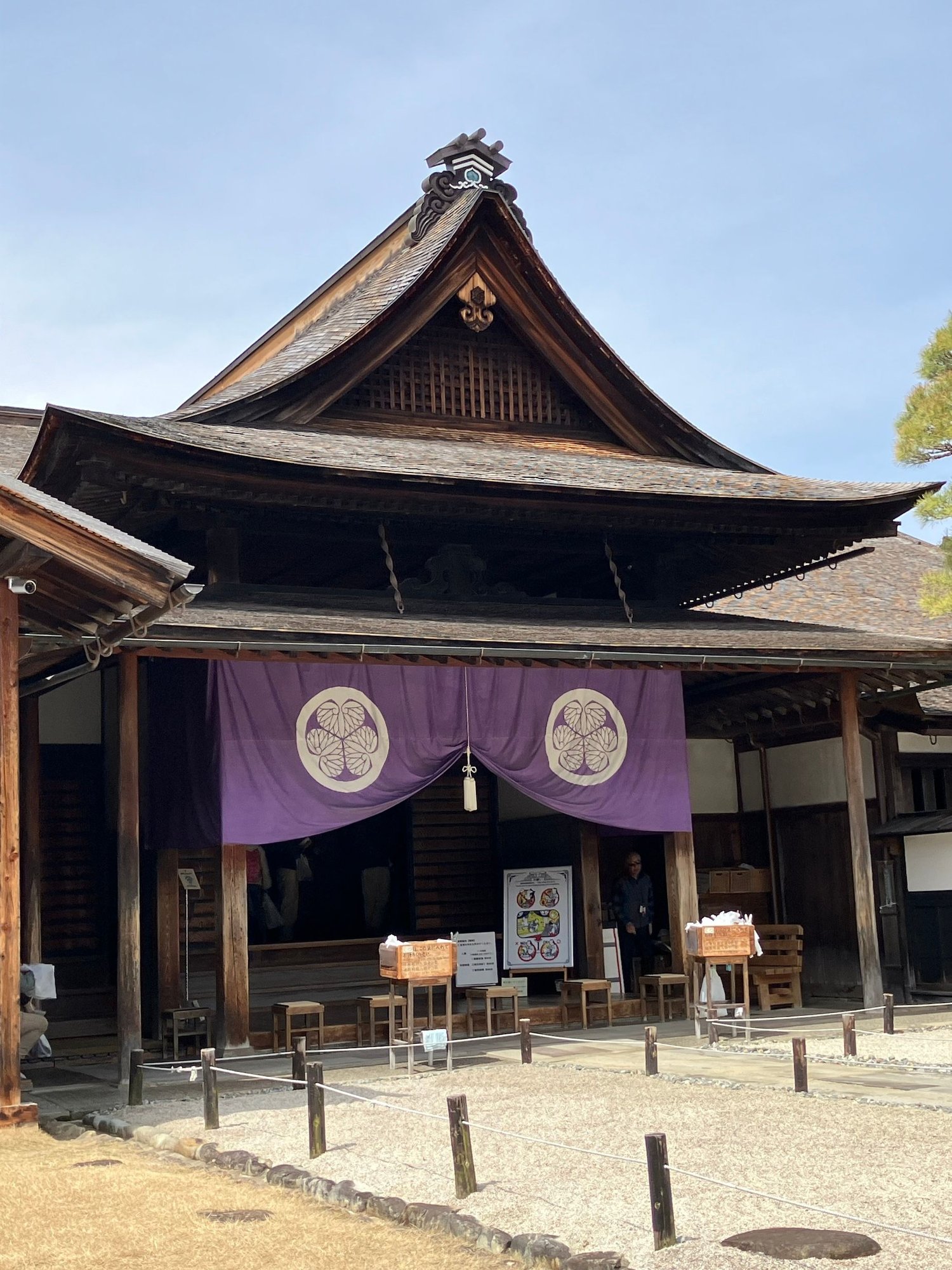
Takayama Jinya entrance
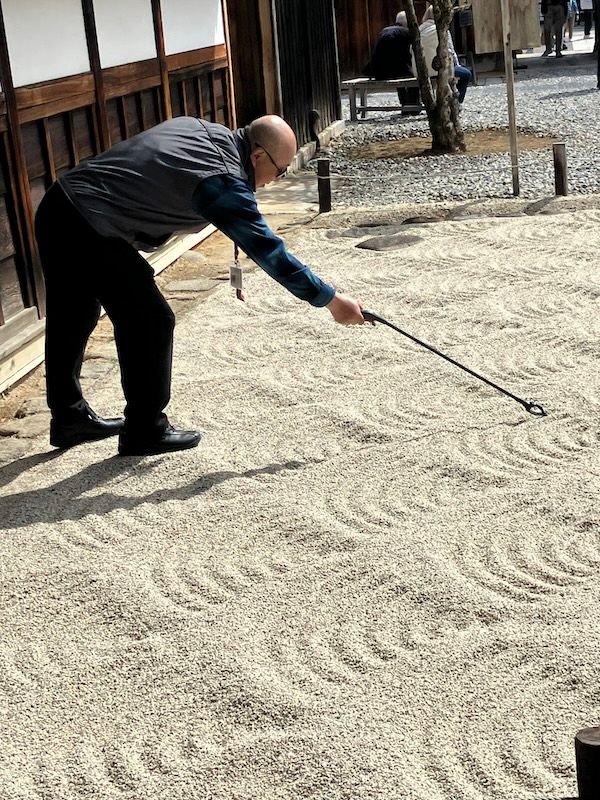
Takayama Jinya - picking up pine needles one at a time

Takayama Jinya - scribe's section of courtroom
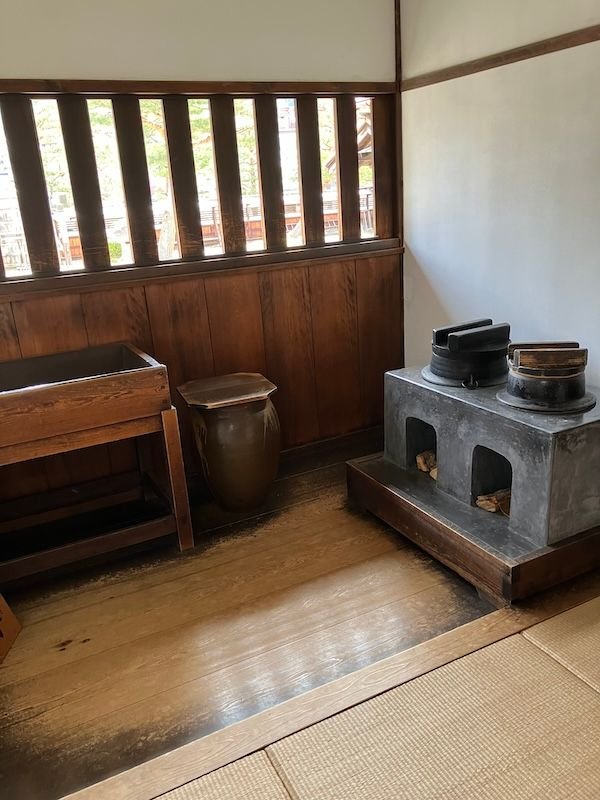
Takayama Jinya - kitchen
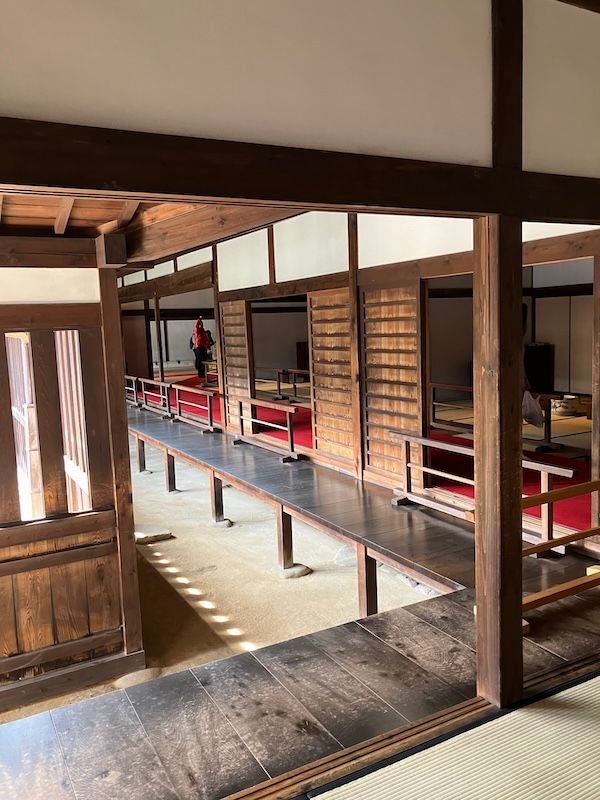
Takayama Jinya - route walkway through complex
When you arrive, you have to take your shoes off and put them in a plastic bag the guard provides and carry your shoes with you. Before going into the building, I was sitting on a bench looking at the plantings and noticed a guard working in a raked gravel garden; he had a picker-upper (long stick with tongs at one end) and was painstakingly picking up one pine needle at a time which had fallen from branches of a long-needled pine tree off to the side. Initially, he was standing at the very edge of the garden reaching in to get the needles, but then he planted one foot in the gravel to reach the farthest needles. I had two thoughts – (1) wow, what attention to detail to maintain the aesthetic purity of the garden and (2) how is he going to remove that footprint while keeping the raked design? So, I asked him if he spoke English and he did; I explained my question and he gestured to wait a minute while he went into the garden shed; he returned with a wooden tool that he uses. It’s not a rake; it’s a wooden base about 18” long with a row of wooden dowels set about 2” apart; each dowel is about 3-4” long. He puts one end in the gravel and pivots the other end to get a fan shape of rows that are perfectly aligned. He said he made it himself. My curiosity was satisfied. (I wonder if the monks in all those temples are using similar tools; I’ve always pictured them methodically making one raked line at a time, in a careful choreography while meditating on nature…)
I got their audio guide at the ticket desk which I thought was well done; it provided explanations about each room and if you wanted more in-depth info, you could press a button to hear more. It is super well organized due to the one-way route through the complex. The only problem is that there’s not a lot of information in English; I had researched beforehand and printed out some stuff which was good, but there was still a lot with no English descriptions. I read a comment somewhere that the lack of furniture made it boring and hard to understand the different purposes of the rooms but the audio guide (and imagination) solves that. This was another place where I could feel the history of centuries. Two particularly interesting spots – in the courtyard I noticed I noticed a very modern water sprinkler system on a pole which was pointed at the wooden walls and roofs (being a timber area, buildings were wood and fire has always been – and I guess still is – the largest threat) and the rice storehouse, which is one of the oldest and largest in Japan (exhibits of tools and photos, plus rice sacks).

Takayama Jinya - rice storehouse; wooden shingles piled up
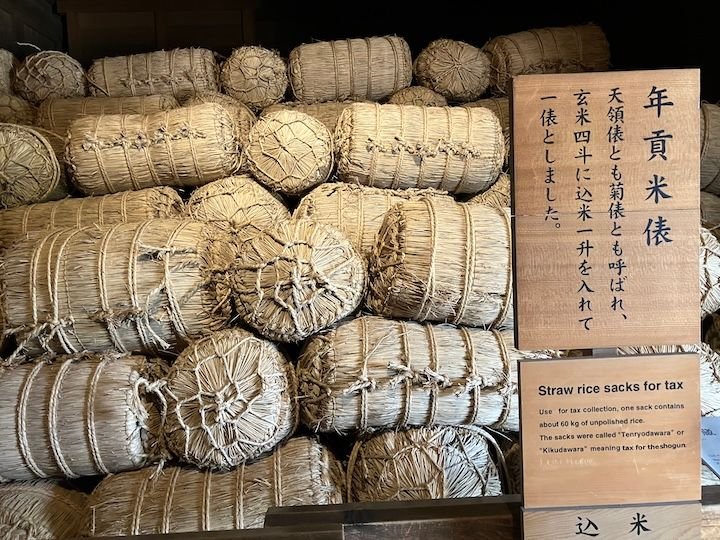
Takayama Jinya - sacks of rice

Takayama Jinya - high tech fire hose/sprinkler
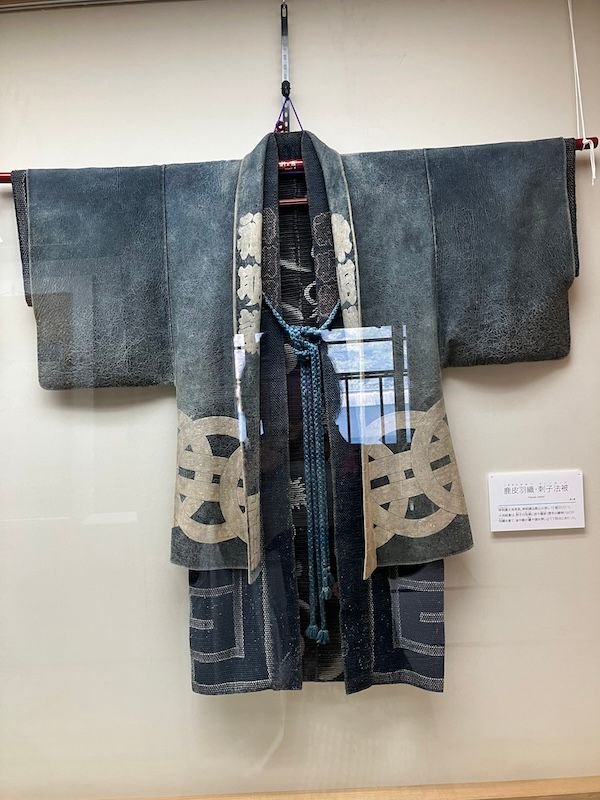
Takayama Jinya - old style fireman's uniform, made of deer hide
I really enjoyed Takayama Jinya and highly recommend seeing it. I spent about 90 mins there. I wandered across the river and along Kami-ichinomachi, a street that parallels Sanmachi Suji street about two streets away. Sanmachi was very crowded but two streets away was much emptier. Lots of shops and residences; there seemed to be a number of antique/junk shops on this street and I enjoyed poking around a couple of them. I had two unexpected but ultimately fun things happen on this street: I was walking along and spotted 2 Americans eating hamburgers on a bench so asked where they got them - they directed me to a tiny restaurant that I had missed; there is a small sign on the street and you walk down a hallway to the restaurant in the back. Center4 Hamburgers’ goal is to offer the best hamburger experience in Takayama. In contrast to EvilTex yesterday, this one is decorated in 60s American gas station style and the sound track is Johnny Cash. It’s very small with about 4 tables and a counter where they seated me. I had a very good cheeseburger and fries.
When I left the hamburger joint I turned left - And what do I see in front of my wondering eyes, but an amazing red and gold float!!

The Takayama Spring festival is next Sunday and Monday and this float is the real thing on a little skinny street right in front of me. In the museums, they said that the actual floats are stored in very tall garages sprinkled throughout Takayama and I had noticed the very tall garage doors of this one as I walked past it to the hamburger joint. It turns out today was the day for the float team to put all the bits and pieces onto the float and make sure everything is in tip-top condition. I watched for an hour; so interesting; they brought out ornate tassels, feathered swords on tall gilt & lacquer poles, tatami mats decorated with the crest to cover the inner workings of the float, ropes to pull the float, polished orbs and gilt finials for the four corners at the top, round reflectors with painted frames and more. There were about 12 men working on this and they had a system. Ladders were brought to one end, then the other end, items were lifted up to a man standing on the top, items were handed to a man inside the float. The gigantic gold painted drum on the top with the gold leaves can be raised or lowered by the man inside the float using a pulley system, which he tested a couple of times. There were some young boys who were helping out also; and next to this float garage all the women on the float team were inventorying costumes and handing out the correct sizes to everybody.
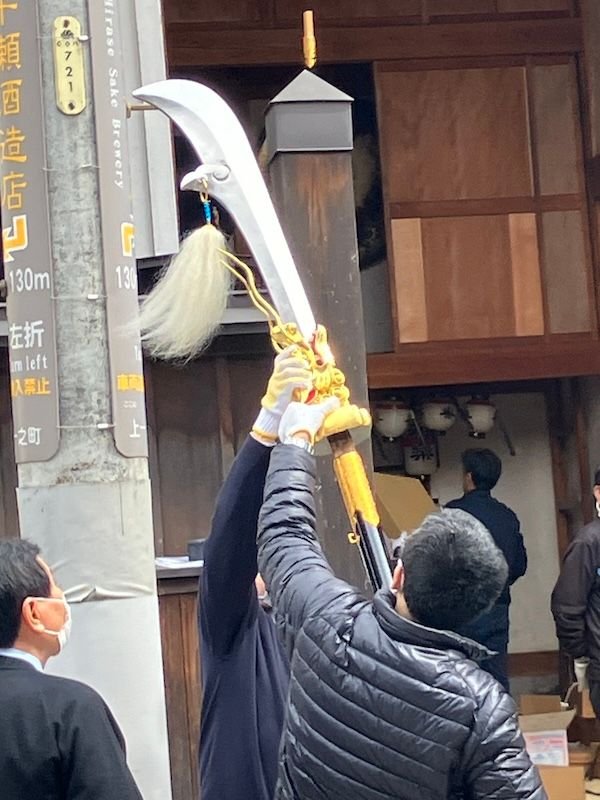
Assembling the tasseled sword
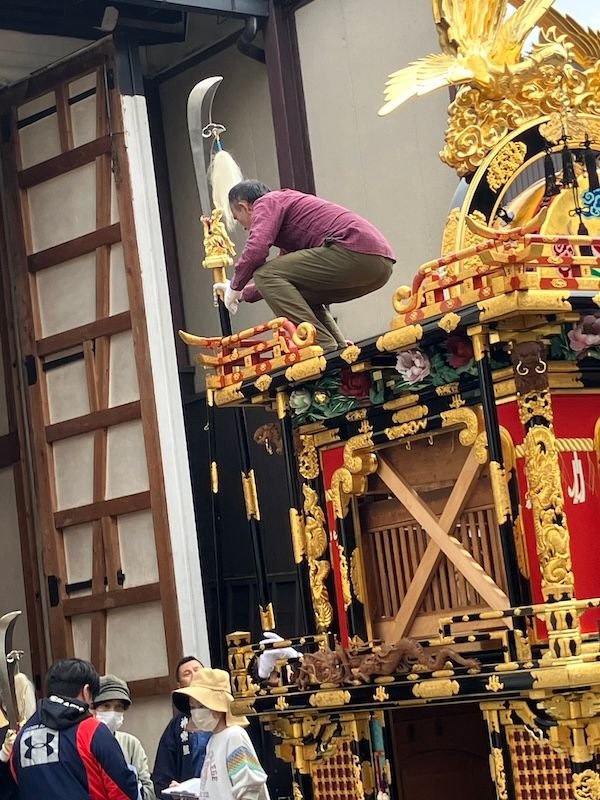
Placing sword
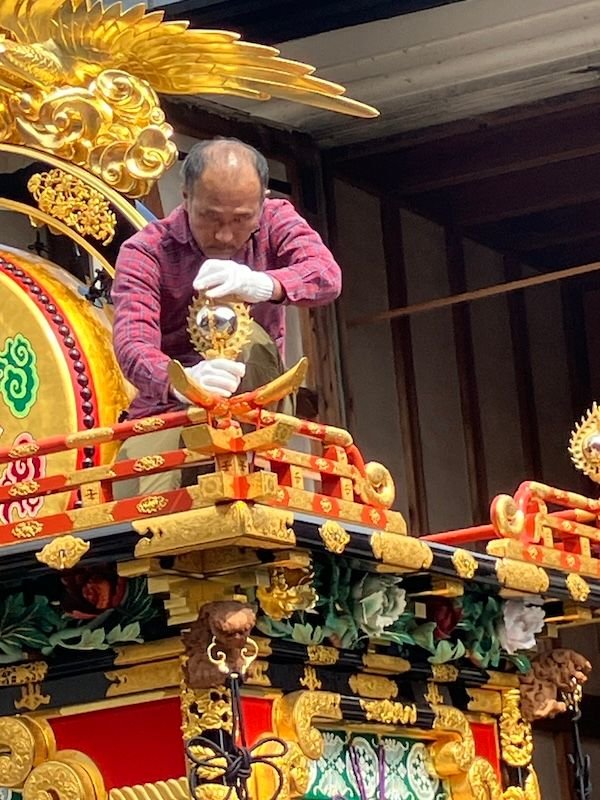
Inserting & polishing the shiny finial (wearing white gloves)
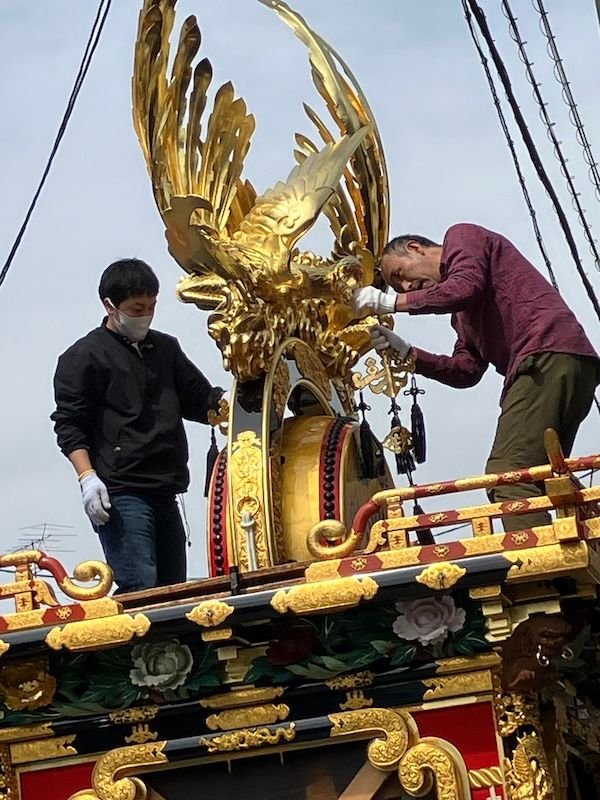
Checking the raising/lowering mechanism of the huge drum
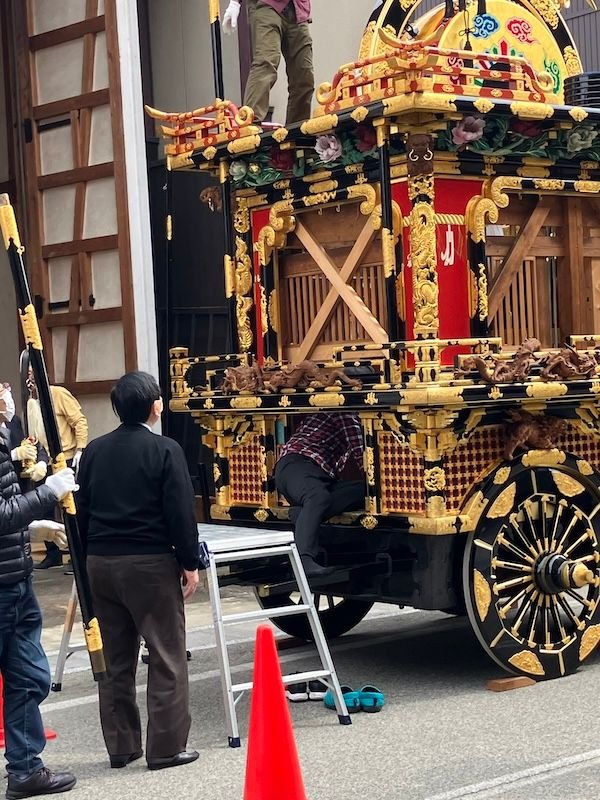
Worker climbing inside the float
Once everything was in its place, the men turned and pushed the float back into the garage and it’s ready for the procession next Sunday; traditionally this ist he first float in the procession. I felt very fortunate to have stumbled across this and have the opportunity to see all the details of the float as well as seeing these folks all working together on something involving tradition.

The finished float
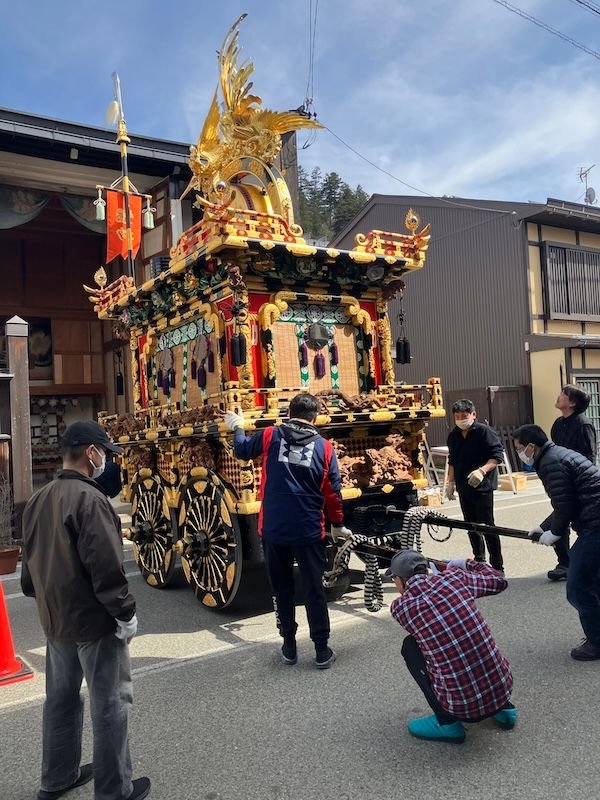
Pushing it back into the garage
It would be hard to beat the float experience but I went to the Takayama Museum of History and Art which is a small complex of interconnected buildings that were originally the storehouses of two wealthy merchant families. Within these buildings are 15 themed exhibits housed on two floors (the exhibits are labelled from 1 to 15 on the museum floor guide and at the museum). Although the layout is bit confusing, the museum provides an excellent overview of the city and is worth visiting (if you’re there for a few days). No admission fee.
Exhibits include “Welcome to the Museum” whilch gives visitors a brief overview of Takayama as a castle town, the culture of the local region, and the history of the museum; Takayama Festival”; “Takayama Machinami and Hida Carpentry” which tells the story of the region’s famed woodwork skills; “History of Takayama as a Castle Town”; history of one of the city’s founding families; folk events; Takayama Artwork; Religion in Takayama is an interesting exhibit that focuses on Enku’s Buddhas. (Enku was a Buddhist monk who traveled throughout Eastern Japan and carved tens of thousands of wooden Buddhas during his priestly training, which he gave away as payment for temple lodgings or as comfort items to those in mourning); “Life and Culture”; Academics and Literature” and finally “Massive Fires and Disaster Prevention” about the history of fire fighting and disaster prevention in Takayama. Since most of the buildings in Japan, or at least Tokyo and all the cities I’ve been in, were traditionally made out of wood, fire was a big hazard. Any description of a building invariably references multiple fires that destroyed the building over the centuries. A map of the forest areas of this province shows that timber was and still is a huge industry.
Wood carving using yew wood is local specialty and I’ve been looking at various carvings in shops but keep reminding myself that I don’t need another “thing” and they’re relatively expensive. On the way back to the hotel I wandered into an antique shop and they had a laughing Buddha carving that I had seen before – or at least similar ones – and this one was less expensive so I bought it.
Back at the hotel and microwaved some chicken yakitori for dinner. It was a very pleasant day; tomorrow is my penultimate day and I take the train to Nagoya.
 . I really wanted to have at least one genuine Japanese meal during my trip so my loss of the wasabi farm was soba noodle gain.
. I really wanted to have at least one genuine Japanese meal during my trip so my loss of the wasabi farm was soba noodle gain.mjs - when I'm on a trip, each night I dictate the day's experiences into an email which I then transcribe and edit once I'm home. They tend to be a bit stream of consciousness so I clean them up for posting - no one wants to hear whining. Last time I was in Japan I ate tonkatsu pretty often and this time I had a lot of fried chicken. I could have spent more time & money in Uniqlo but I had no room in my luggage and really don't need anything; I wish I done the monogrammed bag though...oh well! I lucked out with the yen vs dollar rate so my trip ended up being under budget - which means more money for travels!Day 10 –Takayama (April 6)
overcast with some sun; mid-60s.
Wow, do I love places like this! There’s so much to see and absorb for a history geek; my mind is like a sponge just soaking it all up. On my way to the Takayama Jinya, which was a govt office for the 265 years of the Edo era. Just before you reach the entrance area, is the Jinya-mae Market. Unlike the Miyagawa Market, this market is entirely stands set up in an open area that sell local crafts, snacks and farm products. It felt more local than the other market to me; I bought a mini-apple tart for later and enjoyed looking at all the produce and handmade goods.
Takayama was such an important site that officials were sent from the capital Edo to perform administrative duties like tax collection, finance, court, rulings and police action. This building served as the offices for all those functions as well as residences for the officials sent to do them (and their bodyguards, wives and maids). It seems like a maze of rooms with different administrative purposes, hallways, porches facing onto the interior courtyard, rooms for functionaries to wait their turn in, tea ceremony room, living space (separate areas for the officials and their families versus the maids and bodyguards), separate kitchens. It’s set up with a one-way route through the complex but you can take as much time as you like in each room. It’s a destination for tour groups and individual tourists but most people just walk through like they’re on a race track, whereas I step to the side, study the room, look up and down, look at the exhibits, etc. This is yet another site that I can really picture operating back in the old days and long kimonos sweeping the ground and scribes transcribing everything. Reading Shogun while I’m here has been extremely helpful for me.

Takayama Jinya entrance

Takayama Jinya - picking up pine needles one at a time

Takayama Jinya - scribe's section of courtroom

Takayama Jinya - kitchen

Takayama Jinya - route walkway through complex
When you arrive, you have to take your shoes off and put them in a plastic bag the guard provides and carry your shoes with you. Before going into the building, I was sitting on a bench looking at the plantings and noticed a guard working in a raked gravel garden; he had a picker-upper (long stick with tongs at one end) and was painstakingly picking up one pine needle at a time which had fallen from branches of a long-needled pine tree off to the side. Initially, he was standing at the very edge of the garden reaching in to get the needles, but then he planted one foot in the gravel to reach the farthest needles. I had two thoughts – (1) wow, what attention to detail to maintain the aesthetic purity of the garden and (2) how is he going to remove that footprint while keeping the raked design? So, I asked him if he spoke English and he did; I explained my question and he gestured to wait a minute while he went into the garden shed; he returned with a wooden tool that he uses. It’s not a rake; it’s a wooden base about 18” long with a row of wooden dowels set about 2” apart; each dowel is about 3-4” long. He puts one end in the gravel and pivots the other end to get a fan shape of rows that are perfectly aligned. He said he made it himself. My curiosity was satisfied. (I wonder if the monks in all those temples are using similar tools; I’ve always pictured them methodically making one raked line at a time, in a careful choreography while meditating on nature…)
I got their audio guide at the ticket desk which I thought was well done; it provided explanations about each room and if you wanted more in-depth info, you could press a button to hear more. It is super well organized due to the one-way route through the complex. The only problem is that there’s not a lot of information in English; I had researched beforehand and printed out some stuff which was good, but there was still a lot with no English descriptions. I read a comment somewhere that the lack of furniture made it boring and hard to understand the different purposes of the rooms but the audio guide (and imagination) solves that. This was another place where I could feel the history of centuries. Two particularly interesting spots – in the courtyard I noticed I noticed a very modern water sprinkler system on a pole which was pointed at the wooden walls and roofs (being a timber area, buildings were wood and fire has always been – and I guess still is – the largest threat) and the rice storehouse, which is one of the oldest and largest in Japan (exhibits of tools and photos, plus rice sacks).

Takayama Jinya - rice storehouse; wooden shingles piled up

Takayama Jinya - sacks of rice

Takayama Jinya - high tech fire hose/sprinkler

Takayama Jinya - old style fireman's uniform, made of deer hide
I really enjoyed Takayama Jinya and highly recommend seeing it. I spent about 90 mins there. I wandered across the river and along Kami-ichinomachi, a street that parallels Sanmachi Suji street about two streets away. Sanmachi was very crowded but two streets away was much emptier. Lots of shops and residences; there seemed to be a number of antique/junk shops on this street and I enjoyed poking around a couple of them. I had two unexpected but ultimately fun things happen on this street: I was walking along and spotted 2 Americans eating hamburgers on a bench so asked where they got them - they directed me to a tiny restaurant that I had missed; there is a small sign on the street and you walk down a hallway to the restaurant in the back. Center4 Hamburgers’ goal is to offer the best hamburger experience in Takayama. In contrast to EvilTex yesterday, this one is decorated in 60s American gas station style and the sound track is Johnny Cash. It’s very small with about 4 tables and a counter where they seated me. I had a very good cheeseburger and fries.
When I left the hamburger joint I turned left - And what do I see in front of my wondering eyes, but an amazing red and gold float!!

The Takayama Spring festival is next Sunday and Monday and this float is the real thing on a little skinny street right in front of me. In the museums, they said that the actual floats are stored in very tall garages sprinkled throughout Takayama and I had noticed the very tall garage doors of this one as I walked past it to the hamburger joint. It turns out today was the day for the float team to put all the bits and pieces onto the float and make sure everything is in tip-top condition. I watched for an hour; so interesting; they brought out ornate tassels, feathered swords on tall gilt & lacquer poles, tatami mats decorated with the crest to cover the inner workings of the float, ropes to pull the float, polished orbs and gilt finials for the four corners at the top, round reflectors with painted frames and more. There were about 12 men working on this and they had a system. Ladders were brought to one end, then the other end, items were lifted up to a man standing on the top, items were handed to a man inside the float. The gigantic gold painted drum on the top with the gold leaves can be raised or lowered by the man inside the float using a pulley system, which he tested a couple of times. There were some young boys who were helping out also; and next to this float garage all the women on the float team were inventorying costumes and handing out the correct sizes to everybody.

Assembling the tasseled sword

Placing sword

Inserting & polishing the shiny finial (wearing white gloves)

Checking the raising/lowering mechanism of the huge drum

Worker climbing inside the float
Once everything was in its place, the men turned and pushed the float back into the garage and it’s ready for the procession next Sunday; traditionally this ist he first float in the procession. I felt very fortunate to have stumbled across this and have the opportunity to see all the details of the float as well as seeing these folks all working together on something involving tradition.

The finished float

Pushing it back into the garage
It would be hard to beat the float experience but I went to the Takayama Museum of History and Art which is a small complex of interconnected buildings that were originally the storehouses of two wealthy merchant families. Within these buildings are 15 themed exhibits housed on two floors (the exhibits are labelled from 1 to 15 on the museum floor guide and at the museum). Although the layout is bit confusing, the museum provides an excellent overview of the city and is worth visiting (if you’re there for a few days). No admission fee.
Exhibits include “Welcome to the Museum” whilch gives visitors a brief overview of Takayama as a castle town, the culture of the local region, and the history of the museum; Takayama Festival”; “Takayama Machinami and Hida Carpentry” which tells the story of the region’s famed woodwork skills; “History of Takayama as a Castle Town”; history of one of the city’s founding families; folk events; Takayama Artwork; Religion in Takayama is an interesting exhibit that focuses on Enku’s Buddhas. (Enku was a Buddhist monk who traveled throughout Eastern Japan and carved tens of thousands of wooden Buddhas during his priestly training, which he gave away as payment for temple lodgings or as comfort items to those in mourning); “Life and Culture”; Academics and Literature” and finally “Massive Fires and Disaster Prevention” about the history of fire fighting and disaster prevention in Takayama. Since most of the buildings in Japan, or at least Tokyo and all the cities I’ve been in, were traditionally made out of wood, fire was a big hazard. Any description of a building invariably references multiple fires that destroyed the building over the centuries. A map of the forest areas of this province shows that timber was and still is a huge industry.
Wood carving using yew wood is local specialty and I’ve been looking at various carvings in shops but keep reminding myself that I don’t need another “thing” and they’re relatively expensive. On the way back to the hotel I wandered into an antique shop and they had a laughing Buddha carving that I had seen before – or at least similar ones – and this one was less expensive so I bought it.
Back at the hotel and microwaved some chicken yakitori for dinner. It was a very pleasant day; tomorrow is my penultimate day and I take the train to Nagoya.
#28
Original Poster
Join Date: Sep 2005
Posts: 500
Likes: 0
Received 0 Likes
on
0 Posts
Thanks everyone! I always get so much useful info from other people's trip reports that I like to return the favor. Hopefully this sparked an interest in someone to visit one of these sights.
Thread
Original Poster
Forum
Replies
Last Post
Jackychuah
Asia
3
Aug 27th, 2008 04:54 AM






